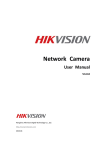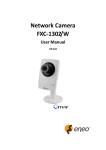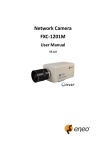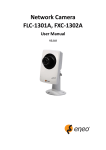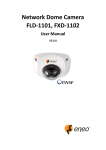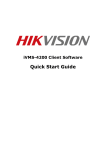Download Network Camera User Manual V3.0.0
Transcript
Network Camera User Manual V3.0.0 Hangzhou Hikvision Digital Technology Co., Ltd. http://www.hikvision.com User Manual of Network Camera 1 Thank you for purchasing our product. If there are any questions, or requests, please do not hesitate to contact the dealer. This manual applies to Network Camera. This manual may contain several technical incorrect places or printing errors, and the content is subject to change without notice. The updates will be added to the new version of this manual. We will readily improve or update the products or procedures described in the manual. DISCLAIMER STATEMENT “Underwriters Laboratories Inc. (“UL”) has not tested the performance or reliability of the security or signaling aspects of this product. UL has only tested for fire, shock or casualty hazards as outlined in UL’s Standard(s) for Safety, UL60950-1. UL Certification does not cover the performance or reliability of the security or signaling aspects of this product. UL MAKES NO REPRESENTATIONS, WARRANTIES OR CERTIFICATIONS WHATSOEVER REGARDING THE PERFORMANCE OR RELIABILITY OF ANY SECURITY OR SIGNALING RELATED FUNCTIONS OF THIS PRODUCT.” Hangzhou Hikvision Digital Technology Co., Ltd. | Copyright © User Manual of Network Camera 2 Regulatory Information FCC Information FCC compliance: This equipment has been tested and found to comply with the limits for a digital device, pursuant to part 15 of the FCC Rules. These limits are designed to provide reasonable protection against harmful interference when the equipment is operated in a commercial environment. This equipment generates, uses, and can radiate radio frequency energy and, if not installed and used in accordance with the instruction manual, may cause harmful interference to radio communications. Operation of this equipment in a residential area is likely to cause harmful interference in which case the user will be required to correct the interference at his own expense. FCC Conditions This device complies with part 15 of the FCC Rules. Operation is subject to the following two conditions: 1. This device may not cause harmful interference. 2. This device must accept any interference received, including interference that may cause undesired operation. EU Conformity Statement This product and - if applicable - the supplied accessories too are marked with "CE" and comply therefore with the applicable harmonized European standards listed under the Low Voltage Directive 2006/95/EC, the EMC Directive 2004/108/EC. 2002/96/EC (WEEE directive): Products marked with this symbol cannot be disposed of as unsorted municipal waste in the European Union. For proper recycling, return this product to your local supplier upon the purchase of equivalent new equipment, or dispose of it at designated collection points. For more information see: www.recyclethis.info. 2006/66/EC (battery directive): This product contains a battery that cannot be disposed of as unsorted municipal waste in the European Union. See the product documentation for specific battery information. The battery is marked with this symbol, which may include lettering to indicate cadmium (Cd), lead (Pb), or mercury (Hg). For proper recycling, return the battery to your supplier or to a designated collection point. For more information see: www.recyclethis.info. Hangzhou Hikvision Digital Technology Co., Ltd. | Copyright © User Manual of Network Camera 3 Safety Warnings and Cautions Please pay attention to the following warnings and cautions: Hazardous Voltage may be present: Special measures and precautions must be taken when using this device. Some potentials (voltages) on the device may present a hazard to the user. This device should only be used by HIKVISION Employees with knowledge and training in working with these types of devices that contain live circuits. Power Supply Hazardous Voltage: AC mains voltages are present within the power supply assembly. This device must be connected to a UL approved, completely enclosed power supply, of the proper rated voltage and current. No user serviceable parts inside the power supply. System Grounding (Earthing): To avoid shock, ensure that all AC wiring is not exposed and that the earth grounding is maintained. Ensure that any equipment to which this device will be attached is also connected to properly wired grounded receptacles and are approved medical devices. Power Connect and Disconnect: The AC power supply cord is the main disconnect device to mains (AC power).The socket outlet shall be installed near the equipment and shall be readily accessible. Installation and Maintenance: Do not connect/disconnect any cables to or perform installation/maintenance on this device during an electrical storm. Hangzhou Hikvision Digital Technology Co., Ltd. | Copyright © 4 User Manual of Network Camera Power Cord Requirements: The connector that plugs into the wall outlet must be a grounding-type male plug designed for use in your region. It must have certification marks showing certification by an agency in your region. The connector that plugs into the AC receptacle on the power supply must be an IEC 320, sheet C13, female connector. See the following website for more information http://kropla.com/electric2.htm. Lithium Battery: This device contains a Lithium Battery. There is a risk of explosion if the battery is replaced by an incorrect type. Dispose of used batteries according to the vendor’s instructions and in accordance with local environmental regulations. Perchlorate Material: Special handling may apply. See www.dtsc.ca.gov/hazardouswaste/perchlorate. This notice is required by California Code of Regulations, Title 22, Division 4.5, Chapter 33: Best Management Practices for Perchlorate Materials. This device includes a battery which contains perchlorate material. Taiwan battery recycling: Please recycle batteries. Thermal and Mechanical Injury: Some components such as heat sinks, power regulators, and processors may be hot; care should be taken to avoid contact with these components. Electro Magnetic Interference: This equipment has not been tested for compliance with emissions limits of FCC and similar international regulations. This device is not, and may not be, offered for sale or lease, or sold, or leased until authorization from the United States FCC or its equivalent in other countries has been obtained. Use of this equipment in a residential location is prohibited. This equipment generates, uses and can radiate radio frequency energy which may result in harmful interference to radio communications. If this equipment does cause harmful interference to radio or television reception, which can be determined by turning the equipment on and off, the user is required to take measures to eliminate the interference or discontinue the use of this equipment. Lead Content: Please recycle this device in a responsible manner. Refer to local environmental regulations for proper recycling; do not dispose of device in unsorted municipal waste. Hangzhou Hikvision Digital Technology Co., Ltd. | Copyright © User Manual of Network Camera 5 Safety Instruction These instructions are intended to ensure that the user can use the product correctly to avoid danger or property loss. The precaution measure is divided into ‘Warnings’ and ‘Cautions’: Warnings: Serious injury or death may be caused if any of these warnings are neglected. Cautions: Injury or equipment damage may be caused if any of these cautions are neglected. Warnings Follow these safeguards to Cautions Follow these precautions to prevent serious injury or death. prevent potential injury or material damage. Warnings: 1. In the use of the product, you must strictly comply with the electrical safety regulations of the nation and region. 2. Source with DC 12V or AC 24V (Whether supporting AC 24V lies on the specific camera model) according to the IEC60950-1 standard. Please refer to technical specifications for more details. 3. Do not connect several devices to one power adapter as an adapter overload may cause over-heating and can be a fire hazard. If use the POE as the power supply, please make sure that the POE Switch have the sufficient power .(Whether supporting PoE power supply lies on the specific camera model) 4. Please make sure that the plug is firmly inserted into the power socket. 5. When the product is installed on a wall or ceiling, the device should be firmly fixed. 6. If smoke, odor, or noise rise from the device, turn off the power at once and unplug the power cable, then contact the service center. 7. If the product does not work properly, please contact your dealer or the nearest service center. Never attempt to disassemble the camera yourself. (We shall not assume any responsibility for problems caused by unauthorized repair or maintenance.) Hangzhou Hikvision Digital Technology Co., Ltd. | Copyright © User Manual of Network Camera 6 Notice: 1. Make sure the power supply voltage is correct before using the camera. 2. Do not drop the camera or subject it to physical shock. 3. Do not touch sensor modules with fingers. If cleaning is necessary, use a clean cloth with a bit of ethanol and wipe it gently. If the camera will not be used for an extended period of time, put on the lens cap to protect the sensor from dirt. 4. Do not aim the camera at the sun or extra bright places. A blooming or smear may occur otherwise (which is not a malfunction however), and affecting the endurance of sensor at the same time. 5. The sensor may be burned out by a laser beam, so when any laser equipment is being used, make sure that the surface of the sensor will not be exposed to the laser beam. 6. Do not place the camera in extremely hot or cold temperatures (the operating temperature should be between -10°C ~ +60°C, dusty or damp locations, and do not expose it to high electromagnetic radiation. 7. To avoid heat accumulation, good ventilation is required for a proper operating environment. 8. While shipping, the camera should be packed in its original packing, or packing of the same texture. 9. Regular part replacement: a few parts (e.g. electrolytic capacitor) of the equipment should be replaced regularly according to their average life time. The average time varies because of differences between operating environment and usage history, so regular checking is recommended for all users. Please contact with your dealer for more details. 10. Improper use or replacement of the battery may result in hazard of explosion. Replace with the same or equivalent type only. Dispose of used batteries according to the instructions provided by the battery manufacturer. Hangzhou Hikvision Digital Technology Co., Ltd. | Copyright © 7 User Manual of Network Camera Table of Contents Chapter 1 Network Camera Connection ...................................................................................................................... 1 1.1 Setting the Network Camera over the LAN ............................................................................................. 1 1.1.1 Wiring over the LAN ................................................................................................................... 1 1.1.2 Detecting and Changing the IP Address....................................................................................... 2 1.2 Setting the Network Camera over the WAN ............................................................................................ 3 1.2.1 Static IP Connection .................................................................................................................... 3 1.2.2 Dynamic IP Connection ............................................................................................................... 3 Chapter 2 Network Access........................................................................................................................................... 6 2.1 Access over IE Browser ................................................................................................................................. 6 2.1.1 Live View............................................................................................................................................ 6 2.1.2 Parameters Configuration ................................................................................................................... 8 2.1.3 Wireless Parameters Configuration................................................................................................... 19 2.2 Access over Client Software ........................................................................................................................ 21 2.2.1 Live View.......................................................................................................................................... 21 2.2.2 Camera Parameters Configuration .................................................................................................... 22 2.2.3 Wireless Parameter Configuration .................................................................................................... 24 Chapter 3 Access over Internet .................................................................................................................................. 26 3.1 Access network camera with static IP .......................................................................................................... 26 3.2 Access network camera with dynamic IP .................................................................................................... 27 Appendix 1 SADP Introduction ................................................................................................................................. 31 Appendix 2 Port Map ................................................................................................................................................ 33 Appendix 3 Pin Definition ......................................................................................................................................... 35 Hangzhou Hikvision Digital Technology Co., Ltd. | Copyright © 1 User Manual of Network Camera Chapter 1 Network Camera Connection Before you start: If you want to set the network camera via a LAN (Local Area Network), please refer to Section 2.1 Setting the Network Camera over the LAN. If you want to set the network camera via a WAN (Wide Area Network), please refer to Section 2.2 Setting the Network Camera over the WAN. 1.1 Setting the Network Camera over the LAN Purpose: To view and configure the camera via a LAN, you need to connect the network camera in the same subnet with your computer, and install the SADP or iVMS-4200 software to search and change the IP of the network camera. Note: For the detailed introduction of SADP, please refer to Appendix 1. 1.1.1 Wiring over the LAN The following figures show the two ways of cable connection of a network camera and a computer: Purpose: To test the network camera, you can directly connect the network camera to the computer with a network cable as shown in Figure 2-1. Refer to the Figure 2-2 to set the network camera over the LAN via a switch or a router. Figure 1-1 Connecting Directly Figure 1-2 Connecting via a Switch or a Router Hangzhou Hikvision Digital Technology Co., Ltd. | Copyright © 2 User Manual of Network Camera 1.1.2 Detecting and Changing the IP Address You need the IP address to visit the network camera. Steps: 1. To get the IP address, you can choose either of the following methods: Use SADP, a software tool which can automatically detect the online network cameras in the LAN and list the device information including IP address, subnet mask, port number, device serial number, device version, etc., shown in Figure 2-3. Use the client software to list the online devices. Please refer to the user manual of client software for detailed information. 2. Change the IP address and subnet mask to the same subnet as that of your computer. 3. Enter the IP address of network camera in the address field of the web browser to view the live video. Notes: The default IP address is 192.0.0.64 and the port number is 8000. The default user name is admin, and password is 12345. For accessing the network camera from different subnets, please set the gateway for the network camera after you logged in. For detailed information, please refer to Section 5.3.1 Configuring TCP/IP Settings. Figure 1-3 SADP Interface Hangzhou Hikvision Digital Technology Co., Ltd. | Copyright © User Manual of Network Camera 3 1.2 Setting the Network Camera over the WAN Purpose: This section explains how to connect the network camera to the WAN with a static IP or a dynamic IP. 1.2.1 Static IP Connection Before you start: Please apply a static IP from an ISP (Internet Service Provider). With the static IP address, you can connect the network camera via a router or connect it to the WAN directly. Connecting the network camera via a router Steps: 1. Connect the network camera to the router. 2. Assign a LAN IP address, the subnet mask and the gateway. Refer to Section 2.1.2 Detecting and Changing the IP Address for detailed IP address configuration of the camera. 3. Save the static IP in the router. 4. Set port mapping, E.g., 80, 8000, 8200 and 554 ports. The steps for port mapping vary depending on different routers. Please call the router manufacturer for assistance with port mapping. Note: Refer to Appendix 2 for detailed information about port mapping. 5. Visit the network camera through a web browser or the client software over the internet. Figure 1-4 Accessing the Camera through Router with Static IP Connecting the network camera with static IP directly You can also save the static IP in the camera and directly connect it to the internet without using a router. Refer to Section 2.1.2 Detecting and Changing the IP Address for detailed IP address configuration of the camera. Figure 1-5 Accessing the Camera with Static IP Directly 1.2.2 Dynamic IP Connection Before you start: Please apply a dynamic IP from an ISP. With the dynamic IP address, you can connect the network camera to a modem or a router. Connecting the network camera via a router Hangzhou Hikvision Digital Technology Co., Ltd. | Copyright © 4 User Manual of Network Camera Steps: 1. Connect the network camera to the router. 2. In the camera, assign a LAN IP address, the subnet mask and the gateway. Refer to Section 2.1.2 Detecting and Changing the IP Address for detailed LAN configuration. 3. In the router, set the PPPoE user name, password and confirm the password. 4. Set port mapping. E.g. 80, 8000, 8200 and 554 ports. The steps for port mapping vary depending on different routers. Please call the router manufacturer for assistance with port mapping. Note: Refer to Appendix 2 for detailed information about port mapping. 5. Apply a domain name from a domain name provider. 6. Configure the DDNS settings in the setting interface of the router. 7. Visit the camera via the applied domain name. Connecting the network camera via a modem Purpose: This camera supports the PPPoE auto dial-up function. The camera gets a public IP address by ADSL dial-up after the camera is connected to a modem. You need to configure the PPPoE parameters of the network camera. Refer to Section 5.3.3 Configuring PPPoE Settings for detailed configuration. Figure 1-6 Accessing the Camera with Dynamic IP Note: The obtained IP address is dynamically assigned via PPPoE, so the IP address always changes after rebooting the camera. To solve the inconvenience of the dynamic IP, you need to get a domain name from the DDNS provider (E.g. DynDns.com). Please follow below steps for normal domain name resolution and private domain name resolution to solve the problem. Normal Domain Name Resolution Figure 1-7 Normal Domain Name Resolution Steps: 1. Apply a domain name from a domain name provider. 2. Configure the DDNS settings in the DDNS Settings interface of the network camera. Refer to Section 5.3.4 Hangzhou Hikvision Digital Technology Co., Ltd. | Copyright © 5 User Manual of Network Camera Configuring DDNS Settings for detailed configuration. 3. Visit the camera via the applied domain name. Private Domain Name Resolution Figure 1-8 Private Domain Name Resolution Steps: 1. Install and run the IP Server software in a computer with a static IP. 2. Access the network camera through the LAN with a web browser or the client software. 3. Enable DDNS and select IP Server as the protocol type. Refer to Section 5.3.4 Configuring DDNS Settings for detailed configuration. Hangzhou Hikvision Digital Technology Co., Ltd. | Copyright © 6 User Manual of Network Camera Chapter 2 Network Access After hardware installation, user can view live video and configure parameters for the network camera, including IP address, subnet mask and port number, etc. The following two methods can be used to access the camera: 1. View live video and configure parameters over IE browser. 2. View live video and configure parameters over client software. 2.1 Access over IE Browser Before access to the camera over IE browser, user should adjust the security level. Open the IE browser, and set the security level to Medium in Tools/ InternetOptions/Security/Custom Level..., and enable or prompt Activex Control and Plug-in directly as well. Fig. 2.1.1 Adjust the Security Level 2.1.1 Live View Step 1: Install Active-X Control Type the IP address of the network camera and press Enter, then the ActiveX mention dialog will pop up. Click Install to install the ActiveX control. Fig. 2.1.2 Install the ActiveX Control Hangzhou Hikvision Digital Technology Co., Ltd. | Copyright © 7 User Manual of Network Camera Step 2: Input the Username (default: admin), Password (default: 12345) and Port (default: 8000) of the camera, and then click [Login]. Fig. 2.1.3 Login Interface Step 3: After successful login, user is allowed to view the live video. Refer to Figure 2.1.4. Fig. 2.1.4 Live View Page Icons on Live View Page: Icon Description Full-screen display mode Exit full-screen display mode Start Preview Stop Preview Capture Picture Start/Stop Record Digital Zoom Video Parameters Hangzhou Hikvision Digital Technology Co., Ltd. | Copyright © 8 User Manual of Network Camera Digital Zoom: Click mouse in the desired position of live video image and scroll the mouse to realize zoom in and zoom out function. Video Parameters: Icon Description Brightness: 0~100 configurable Contrast: 0~100 configurable Saturation: 0~100 configurable Hue: 0~100 configurable Gain: 0~100 configurable Exposure time: 0~40000 configurable Restore default Fig. 2.1.5 Video Parameters Note: Gain value is not configurable when the Day/Night mode is ‘Auto’. 2.1.2 Parameters Configuration Click Configuration to enter the Parameters Configuration interface. 2.1.2.1 Local Configuration Fig. 2.1.6 Local Configuration Hangzhou Hikvision Digital Technology Co., Ltd. | Copyright © 9 User Manual of Network Camera Local Configuration: Parameters Description Protocol type TCP and UTP selectable Stream type Main stream and Sub stream selectable Display mode Full-screen, 4:3 mode, 16:9 mode or adjustable to resolution Package file size Transmission performance 128M, 256M, 512M selectable Shortest delay mode, good real-time, normal real-time and fluency and good fluency options selectable Save record file as The default directory for saving record files is C: \OCXRecordFiles, which can be modified by user Save captured picture as The default directory for saving captured files is C:\OCXBMPCaptureFiles, which can be modified by user 2.1.2.2 Remote Configuration Basic Information: In the Basic Information settings interface, user is allowed to set the Device Name and Device ID, as well as view the information of IP camera, including Device Description, Device Location, MAC address, Device Type, Device SN, Firmware Version, and U-boot Version. Fig. 2.1.7 Basic Information Hangzhou Hikvision Digital Technology Co., Ltd. | Copyright © 10 User Manual of Network Camera Channel ParametersDisplay Setting: According to different requirements, enable the display of Date&Time and Week by clicking the checkbox. Different date formats can be selected. The OSD Status can be set to transparent & flickering, transparent & unflickering, nontransparent & flickering, or nontransparent & unflickering. Fig. 2.1.8 Display Settings Channel ParametersVideo Settings: Fig. 2.1.9 Video Settings Parameter Description Stream Type Select stream type to Main stream or Sub stream Resolution Image Quality Stream Type Max. Bitrate Select the resolution for your need, Select image quality to Highest, High, Medium, Low, Lower or Lowest Select the bitrate type to Constant bitrate or Variable bitrate Select or custom bitrate according to the resolution Multicast Set the multicast address, with the default multicast of 0.0.0.0 RTSP Port Set the RTSP port, with the default RTSP port of 554 Hangzhou Hikvision Digital Technology Co., Ltd. | Copyright © 11 User Manual of Network Camera Channel ParametersMotion Detection Setting: Select the checkbox of Enable motion detection to enable this function. Zone Settings: Click Start draw button to draw motion detection zone by clicking and dragging the mouse in the live video image. User is allowed to draw multiple motion detection zones in the same picture. When all zones have been set, click Stop draw to finish drawing. Sensitivity: The sensitivity level can be set to 0, 1, 2, 3, 4 and 5. When it is set to 0, the sensitivity is disabled. Linkage: The Linkage method can be selected to either Email link or Trigger alarm output. Click "Save" button to save the modified parameters. Fig. 2.1.10 Motion Detection Zone Settings Fig. 2.1.11 Motion Detection Linkage Settings Hangzhou Hikvision Digital Technology Co., Ltd. | Copyright © 12 User Manual of Network Camera Channel ParametersText Overlay Setting: Input the characters in the Text Information box and define the OSD location in the image by setting the XPosition and YPosition, and then select the checkbox of OSD Text. After clicking Save to finish the settings, the defined title will be displayed on the image. Note: The values of XPosition and YPositon are relative to the upper left corner origin of the image. Fig. 2.1.12Text Overlay Settings Network ParametersNetwork Setting: Set the IP Address, Subnet Mask, Gateway and DNS Server of the network camera. Click "Save" button to save the modified parameters. Note: Please reboot the network camera to validate the modified parameters. Fig. 2.1.13 Network Settings Hangzhou Hikvision Digital Technology Co., Ltd. | Copyright © 13 User Manual of Network Camera Network ParametersPPPOE Setting: Click the checkbox of Enable PPPOE to enable this function. Input the PPPOE user name and password in the text box and then click Save to finish settings. After reboot, the camera will obtain a public IP address. Click "Save" button to save the modified parameters. Note: Please reboot the network camera to validate the modified parameters. Fig. 2.1.14 PPPOE Settings Network ParametersDDNS Setting: Click the checkbox of Enable DDNS to enable this function. The protocol type can be set to DynDNS or IPServer. Click "Save" button to save the modified parameters. Note: Please reboot the network camera to validate the modified parameters. If the protocol type is selected to DynDNS, please input the Server Address, e.g., members.dyn dns. org. The User Name and Password refer to the user name and password registered in the DynDNS website. The Device Name refers to the domain name applied in the DynDNS website. Click "Save" button to save the modified parameters. Note: Please reboot the network camera to validate the modified parameters. Fig. 2.1.15 DDNS Settings Fig. 2.1.16 DynDNS Settings Hangzhou Hikvision Digital Technology Co., Ltd. | Copyright © 14 User Manual of Network Camera If the protocol type is selected to IPServer, please input the Server Address of the IPServer. Click "Save" button to save the modified parameters. Note: Please reboot the network camera to validate the modified parameters. Fig. 2.1.17 IPServer Settings Network ParametersNTP Setting: Click the checkbox of Enable NTP to enable this function. Input the Server Address and Port of NTP. If the public network is applied, please input the NTP Server Address with provision of time sync service, e.g., 210.72.145.44. In the private network is applied, the NTP software can be used to establish NTP server to achieve time synchronization. Click "Save" button to save the modified parameters. Note: Please reboot the network camera to validate the modified parameters. Fig.2.1.18 NTP Settings Hangzhou Hikvision Digital Technology Co., Ltd. | Copyright © 15 User Manual of Network Camera Network ParametersE-mail Setting: Through E-mail settings, the alarm message can be sent to the designated E-mail address when alarm event occurs. Input the SMTP server, SMTP port, user name, password, E-mail sender and receiver, and finally click Save to finish E-mail settings. Click "Save" button to save the modified parameters. Note: Please reboot the network camera to validate the modified parameters. Fig. 2.1.19 E-mail Settings Alarm ParametersAlarm Input Setting: Set the type of Relay Status to NC or NO. The Linkage method can be selected to E-mail link or Trigger alarm output. Click "Save" button to save the modified parameters. Fig. 2.1.20 Alarm Input Settings Alarm ParametersAlarm Output Setting: The Output Delay refers to the length of time that the relay remains in effect after alarm occurs. The output delay time can be set to 5sec, 10sec, 30sec, 1min, 2min, 5min, 10min or Manual (manually disable). Click "Save" button to save the modified parameters. Fig. 2.1.21 Alarm Output Delay Settings Hangzhou Hikvision Digital Technology Co., Ltd. | Copyright © 16 User Manual of Network Camera Alarm Deployment Time: The Deployment time can be set to several days a week or to all week, with only one period configurable for each day. Note: The alarm deployment time setting is valid only when the camera has already been configured with the motion detection, alarm input and alarm output functions. Fig. 2.1.22 Alarm Deployment Time Settings Click "Save" button to save the modified parameters. User Management: Fig. 2.1.23 User Management When the current login user is admin, it is allowed to create other users. Up to 15 users can be created. Refer to Fig. 2.1.23. Add User: Click Add to enter the settings interface as shown in Fig. 2.1.24. Input the user name, password, IP address, MAC address, and then select user type. Finally, click OK to finish the user addition. Fig. 2.1.24 Add User Hangzhou Hikvision Digital Technology Co., Ltd. | Copyright © 17 User Manual of Network Camera Modify User: Click Modify to enter the settings interface as shown in Fig. 2.1.25. It is allowed to modify the user name, password, IP address, MAC address, and then select user type. Finally, click OK to finish the user modification. Note: Only the password of the user admin can be modified. Fig. 2.1.25 Modify User Remote Upgrade: Click Browse to select the local update file and then click Upgrade to finish remote upgrade. Fig. 2.1.26 Remote Upgrade Restore Default: Select Full Mode or Basic Mode to restore the default settings. Note: The Full Mode refers to restore all parameters to the factory default settings. The Basic Mode refers to restore the parameters to factory default settings except IP address, subnet mask, gateway and port. Fig. 2.1.27 Restore Default Hangzhou Hikvision Digital Technology Co., Ltd. | Copyright © 18 User Manual of Network Camera Reboot Device: Click OK to reboot the network camera. Fig. 2.1.28 Reboot Device 2.1.2.3 Advanced Configuration Note: This chapter is applicable to professional configuration. 1: Input the IP address of the network camera and “config” (Such as http://172.6.42.105/config), and then click [Enter]. Fig. 2.1.29 2: Type the Username (default: admin), Password (default: 12345) and Port (default: 8000) of the camera, and then click [Login]. Fig. 2.1.30 Hangzhou Hikvision Digital Technology Co., Ltd. | Copyright © 19 User Manual of Network Camera 3: The “Remote config” dialog will pop up, which has more advanced settings including schedule record and HDD settings and so on. Fig. 2.1.31 Please refer to “Client Software-4000(v2.0)_ENG.pdf” for a more detailed parameters configuration. You can find the document in the PC Operating System after the installation of client software 4000 v. 2.0 by selecting “Start”-> “All Programs”-> “client software 4000 v. 2.0”. 2.1.3 Wireless Parameters Configuration Note: This section is only for wireless network camera with mark '-W' in the model number. Before configuring the wireless network camera, please set the wireless router first. For more details about wireless router configuration, please refer to the wireless router configuration instructions. There are two network interface cards in the camera: wired network interface card and wireless network interface card. The factory default settings of wired network interface card are IP address: 192.0.0.64, port number: 8000, superuser: admin, superuser password: 12345, while the default IP address of wireless network interface card is 192.168.1.64. Before accessing to the wireless network camera through wireless network, use the wired Ethernet port of the wireless network camera to configure parameters of wireless network interface card. The configuration steps are the same way as section 1.3. If users want to configure the wireless parameters through IE browser, enter the remote parameter settings interface first. Refer to section '2.1.2.3 Advanced Configuration' for more detailed settings. After entering the remote parameter settings interface, select "WiFi parameters"-> "WiFi Settings" to enter the WiFi settings interface, as shown in figure 2.1.32. Hangzhou Hikvision Digital Technology Co., Ltd. | Copyright © 20 User Manual of Network Camera Fig. 2.1.32 WiFi Settings Interface In the WiFi settings interface, if user select Ad-Hoc mode as the operating mode, please set the PC's wireless IP address in the same network segment as the IP address of wireless network camera. Select "View Wireless Networks" in the computer's "Wireless Network Connection". Find the device which has the same name as the SSID number of the wireless camera. Then point-to-point communication through wireless network is established successfully. So, there is no need to use an Access Point (AP) between the PC and wireless network camera. If users need to enable encryption, select the appropriate encryption type and set the corresponding encryption parameters. In the remote parameter settings interface, select "WiFi parameters"-> "Wlan Settings" to enter the Wlan settings interface, as shown in Fig. 2.1.33. Fig. 2.1.33 Wlan Settings Interface In the "Wlan settings" interface, user can set the wireless network camera's parameters like wireless Hangzhou Hikvision Digital Technology Co., Ltd. | Copyright © 21 User Manual of Network Camera IP address, subnet mask, gateway and DNS server address, etc. Unplug the network cable from wireless network camera. The wireless network camera now can be accessed through wireless network after the related network parameters have been set. The way that accesses to wireless network camera through wireless network is similar to cable network. Refer to section 2.1. 2.2 Access over Client Software Please refer to “iVMS-4000(v2.0) introductor.pdf” for detailed client software installation. You can find the document in the PC Operating System after the installation of client software 4000 v. 2.0 by selecting “Start”-> “All Programs”-> “iVMS 4000( v. 2.0)” -> “iVMS 4000( v. 2.0)”. 2.2.1 Live View Right click to add devices in the setup interface of client software. Please refer to “iVMS-4000(v2.0) introductor.pdf” for more detailed device added process. You can find the document in the PC Operating System after the installation of client software 4000 v. 2.0 by selecting “Start”-> “All Programs”-> “iVMS 4000( v. 2.0)” -> “iVMS 4000( v. 2.0)”. Click Preview, and then double click the device name in the left tree to view the live video. Refer to Fig. 2.2.1. Fig. 2.2.1 Preview Please refer to “iVMS-4000(v2.0) introductor.pdf” for more detailed parameters configuration. You can find the document in the PC Operating System after the installation of client software 4000 v. Hangzhou Hikvision Digital Technology Co., Ltd. | Copyright © 22 User Manual of Network Camera 2.0 by selecting “Start”-> “All Programs”-> “iVMS 4000( v. 2.0)” -> “iVMS 4000( v. 2.0)”. 2.2.2 Camera Parameters Configuration Note: Different types of network cameras maybe have different configuration parameters in the interface of “Config Sensor Parameters”. This section takes a type of network camera for example to introduce configuration parameters in the interface of “Config Sensor Parameters”. If the information in the actual interface of “Config Sensor Parameters” is not different from the information shown in this section, then subject to the actual interface information. For viewing better image, you can set the parameters of the camera, and operate as following: Step 1: Right click in the preview window, and click [Config Sensor Parameters…], then the [Config Sensor Parameters…] box will pop up. Fig. 2.2.2 Sensor Parameters Step 2: Video Parameters Configuration Adjust the value of “Brightness”, “Contrast”, “Saturation”, “Hue”, “Sharpness” and “Gain” for your need, which can be set from 1 to 100. Fig. 2.2.3 Video Parameters Hangzhou Hikvision Digital Technology Co., Ltd. | Copyright © 23 User Manual of Network Camera Step 3: White Balance Configuration Select the mode to Auto1 or Off for your need. Fig. 2.2.4 White Balance Step 4: Exposure Configuration Select “Exposure time” and “Iris mode” for your need. Fig. 2.2.5 Exposure Step 5: Day/Night Mode Configuration Select “Day”, “Night” or “Auto” mode in Mode and adjust the value of “Day->Night”, “Night->Day”, and “Filter time” for your need. Fig. 2.2.6 Day/ Night Mode Hangzhou Hikvision Digital Technology Co., Ltd. | Copyright © 24 User Manual of Network Camera Step 6: Other Parameters Configuration Select the value of “Power Line”, “Mirror”, “E-PTZ” and “Local Output”. Fig. 2.2.7 Other Parameters Please refer to “iVMS-4000(v2.0) introductor.pdf” for more detailed parameters configuration. You can find the document in the PC Operating System after the installation of client software 4000 v. 2.0 by selecting “Start”-> “All Programs”-> “iVMS 4000( v. 2.0)” -> “iVMS 4000( v. 2.0)”. 2.2.3 Wireless Parameter Configuration Note: This section is only for wireless network camera with mark '-W' in the model number. Click “setup” in the client software to enter the devices management interface. Right click the device that needs to be configured, select “Remote Configuration” to enter the remote configuration interface. The way to configure the parameters in the client software is the same as the way in IE browser. Please refer to section 2.1.3 for more detailed parameters configuration. Hangzhou Hikvision Digital Technology Co., Ltd. | Copyright © 25 User Manual of Network Camera Fig. 2.2.8 Client Software Wireless Configuration Interface Hangzhou Hikvision Digital Technology Co., Ltd. | Copyright © 26 User Manual of Network Camera Chapter 3 Access over Internet 3.1 Access network camera with static IP When there is a static IP from an ISP, open some ports (such as 80 and 8000 ports) in the router. Then a user can visit it through a web browser or client software via the internet. The steps for port forwarding are different for each model of router. Please call the router manufacturer for assistance with port forwarding or visit www.portforward.com. Note: Refer to Appendix 2 for a detailed explanation about Port Map. Users can directly connect the network camera to the internet without using a router. Fig. 3.1.1 Access IPC through Router with Static IP Fig.3.1.2 Access IPC with Static IP directly For the client software to view the camera, in the adding equipment column, select the normal model, and then fill in the IP info. Hangzhou Hikvision Digital Technology Co., Ltd. | Copyright © 27 User Manual of Network Camera Fig. 3.1.3 Selecting Normal IP 3.2 Access network camera with dynamic IP Fig. 3.2.1 Access IPC through PPPoE Dial-up This camera supports the PPPoE auto dial-up function. The camera will get a public IP address by ADSL dial-up after the camera is connected to a Modem; First, access to the network camera through local network, select “Configure””Right Click the Device”, “Remote Configuration”, and finally select “PPPoE Settings” under “Network Parameters” to fill in the PPPoE user name and password and confirm the password. Please restart the network camera after completion of configuration. Then the network camera can obtain a dynamic IP from an ISP operation business. However, the obtained IP address is dynamically assigned via PPPoE, so the IP address always changes accompanied with modem rebooting. Hangzhou Hikvision Digital Technology Co., Ltd. | Copyright © 28 User Manual of Network Camera Fig. 3.2.2 PPPoE configuration Dialog box It is inconvenient to view a network camera with a dynamic IP, therefore, users should register with a dynamic DNS provider. (Such as DynDns.com) Domain name resolution contains normal domain name resolution and private domain name resolution. First, we will introduce normal domain name resolution. 1. Normal Domain Name Resolution Fig. 3.2.3 Normal Domain Name Resolution Apply a domain name from a domain name provider, then view the camera via the applied domain name. If the camera connects to the internet via a router, users should port forward the router. Please refer to Appendix 2. Input domain names in the client software or IE to view the network cameras. Take the client Hangzhou Hikvision Digital Technology Co., Ltd. | Copyright © 29 User Manual of Network Camera software configuration as an example. Fig. 3.2.4 Selecting Normal Domain Mode Hangzhou Hikvision Digital Technology Co., Ltd. | Copyright © 30 User Manual of Network Camera 2. Private Domain Name Resolution Fig. 3.2.5 Private Domain Name Resolution A PC with a static IP which is running the domain name resolution service is necessary. When the network camera connects to the internet through PPPoE and obtains an IP address, it will send its name and IP address to the resolution server. When the client software connects to the network camera, it will connect to the resolution server and tell the resolution server the expected camera’s name. And the server will find the camera from all the registered cameras and send its IP address to the client software. Once the client software gets the IP address, it can connect the network camera. Fig. 3.2.6 Selecting Private Domain Mode Hangzhou Hikvision Digital Technology Co., Ltd. | Copyright © 31 User Manual of Network Camera Appendix 1 SADP Introduction Description of SADP V 2.0 SADP (Search Active Devices Protocol) is a kind of user-friendly and installation-free online device search tool. It searches the active online devices within your subnet and displays the information of the devices. You can also modify the basic network information of the devices using this software. Search active devices online Search online devices automatically After launch the SADP software, it automatically searches the online devices every 15 seconds from the subnet where your computer locates. It displays the total number and information of the searched devices in the Online Devices interface. Device information including the device type, IP address, port number, gateway, etc. will be displayed. Note: Device can be searched and displayed in the list in 15 seconds after it went online; it will be removed from the list in 45 seconds after it went offline. Search online devices manually You can also click to refresh the online device list manually. The newly searched devices will be added to the list. Note: You can click or on each column heading to order the information; you can click expand the device table and hide the network parameter panel on the right side, or click the network parameter panel. Hangzhou Hikvision Digital Technology Co., Ltd. | Copyright © to to show 32 User Manual of Network Camera Modify network parameters Steps: 1. Select the device to be modified in the device list and the network parameters of the device will be displayed in the Modify Network Parameters panel on the right side. 2. Edit the modifiable network parameters, e.g. IP address and port number. 3. Enter the password of the admin account of the device in the Password field and click changes. Restore default password Steps: 1. Contact our technical engineers to get the serial code. Note: Serial code is a series of characters combined by the start time and the serial number of the device. 2. Input the code in the Serial code field and click to restore the default password. Hangzhou Hikvision Digital Technology Co., Ltd. | Copyright © to save the 33 User Manual of Network Camera Appendix 2 Port Map Note: The following setting is about TP-LINK router (TL-R410), which is maybe distinct from other router’s setting. 1. Firstly, select the router’s WAN connection Type. As the following Fig. shows: 2. Set the “network parameter” of the router as the below figure. The setting includes subnet mask and gateway. 3. Set the port map in the virtual severs of Forwarding. By default, camera uses port 80, 8000, 554 and 8200. You can change these ports value with IE or client software. The following figure gives the illustration. One camera’s ports are 80, 8000, 554, 8200 and its IP address is 192.168.1.23. The other camera’s ports are 81, 8001, 555, 8201 and IP is 192.168.1.24. Afterwards, enable all or TCP protocols. Enable the port map after pressing the ‘Save’. Hangzhou Hikvision Digital Technology Co., Ltd. | Copyright © User Manual of Network Camera 34 As the settings mentioned above, map the router’s port 80 and 8000 to the network camera at 192.168.1.23; and port 81 and 8001 to the network camera at 192.168.1.24. In this way, user can access the 192.168.1.23 through accessing the router’s port 80 and 8000. Note: The port of the network camera cannot conflict with other ports. For example, some router’s web management port is 80. User can amend the router’s or the camera’s port to solve this problem. Hangzhou Hikvision Digital Technology Co., Ltd. | Copyright © User Manual of Network Camera Appendix 3 Pin Definition (1)UTP between the network port of camera and HUB (Direct Cable) (2)UTP between the network port of camera and PC (Cross Cable): Hangzhou Hikvision Digital Technology Co., Ltd. | Copyright © 35 User Manual of Network Camera First Choice for Security Professionals Hangzhou Hikvision Digital Technology Co., Ltd. | Copyright © 36















































